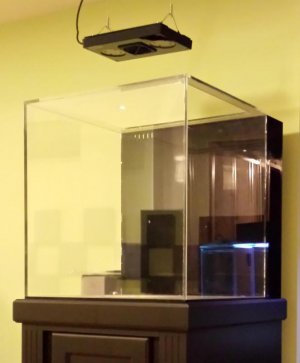Floyd R Turbo
Either busy or sleeping
Depends on how well you build it (edge prep, bonding technique, quality of vertical joints) and how many baffles you have & where. I personally don't build anything with walls less than 3/8" because the price difference is pretty negligible on a full sheet. 1/4" just doesn't give you much bonding area, why skimp, anything that holds water is a critical component.
You have to build it according to the worst case scenario. I always make sumps with enough excess capacity above operating level so that you can take the draw-down from the tank on a power outage + whatever your ATO reservoir holds. So this would take care of a situation where your ATO accidentally emptied out completely right after you filled it, and then you had a power outage. Then, the sump must hold that much water for a potentially extended period of time without blowing up.
IMO rimless can be done as long as your walls are 3/8" thick and you have baffles often enough such that there is no section that is longer than about 12-16". Bond the baffles in at the same time as the ends, not after. This allows you to use pins and get a strong (and structural) bond on both sides of the baffle. For baffles with a water height difference, I use 3/8" also, 1/4" for all others (like the 'up' baffles, etc).
If you do go with 1/4" all around, definitely need a euro. Again with the baffles adding strength, you can usually go with a perimeter only euro of say 2". Make sure you do 2" radius corners, this is the point where the stress gets focused. Also knock down **all** sharp edges with a razor blade (this also relieves stress focus points)
You have to build it according to the worst case scenario. I always make sumps with enough excess capacity above operating level so that you can take the draw-down from the tank on a power outage + whatever your ATO reservoir holds. So this would take care of a situation where your ATO accidentally emptied out completely right after you filled it, and then you had a power outage. Then, the sump must hold that much water for a potentially extended period of time without blowing up.
IMO rimless can be done as long as your walls are 3/8" thick and you have baffles often enough such that there is no section that is longer than about 12-16". Bond the baffles in at the same time as the ends, not after. This allows you to use pins and get a strong (and structural) bond on both sides of the baffle. For baffles with a water height difference, I use 3/8" also, 1/4" for all others (like the 'up' baffles, etc).
If you do go with 1/4" all around, definitely need a euro. Again with the baffles adding strength, you can usually go with a perimeter only euro of say 2". Make sure you do 2" radius corners, this is the point where the stress gets focused. Also knock down **all** sharp edges with a razor blade (this also relieves stress focus points)

